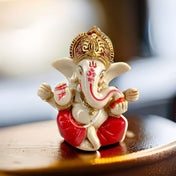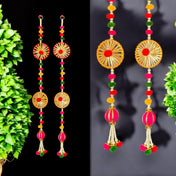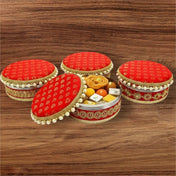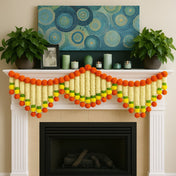Introduction
Navratri is a vibrant Hindu festival dedicated to Goddess Durga. It celebrates the triumph of good over evil through nine nights of devotion, dance, and cultural rituals. This auspicious occasion holds deep spiritual significance and invites communities to come together in joyous reverence. The concept of Sustainable Celebrations blends seamlessly with LoveNspire’s mission — to bridge tradition with innovation while championing eco-consciousness. By choosing eco-friendly Navratri practices, such as using handmade candle holders for lighting decorations, we not only preserve sacred customs but also embody responsible stewardship of nature through thoughtfully curated, handmade, and ethnic products.
As we explore the importance of each day during this festival, it's crucial to understand the distinct meaning that each night represents. For example, Navratri Day 2 is dedicated to Maa Brahmacharini, symbolizing penance and devotion. Discover how to honor Navratri festival significance through nine inspiring ideas for an eco-friendly Navratri that uplifts spirit and environment alike. You can also explore some personalized options like gift boxes or traditional idols that can add a special touch to your celebrations.
Understanding Sustainable Environmentally Friendly Celebrations During Navratri
Sustainable Navratri embraces cultural preservation while minimizing the environmental impact of festivities. A celebration becomes sustainable when it harmonizes traditional values with eco-conscious choices, creating a meaningful yet responsible experience.
Challenges in Conventional Navratri Practices
Some common challenges in conventional Navratri practices include:
- Use of Plaster of Paris (PoP) idols causing water pollution during immersion
- Excessive plastic waste from disposable decor and packaging
- Non-biodegradable materials overwhelming local waste systems
These issues contradict the spiritual essence of Navratri, which honors nature and divine energy.
Eco-Conscious Festivities with LoveNspire Eco-Friendly Decor, Rangoli, Garba and Dandiya Items 
LoveNspire champions eco-conscious festivities by offering handmade and ethnic products crafted with care. Our collection of Navratri pooja items, navratri gifts, and navratri decoration ideas highlights biodegradable materials and traditional craftsmanship. Each piece supports artisans and reduces environmental burden, encouraging celebrations that cherish tradition without compromise. Engaging with such authentic, sustainable options enhances the joy of Navratri while respecting our planet’s wellbeing. For instance, exploring our Navratri collection can provide you with eco-friendly pooja items and decorations that align with sustainable practices.
Significance of Each Day During Navratri for Celebrating Eco-Friendly Navratri
Moreover, each day of Navratri holds special significance, like Day 1 when we honor Shailaputri, or Day 6 dedicated to Katyayani, the Warrior Goddess, which we can celebrate with meaningful gifts. If you're looking for some thoughtful presents during this festive season, our blog on 10 Navratri gifting ideas in the USA offers some great suggestions.
1. Choosing Natural Clay Idols for Pooja as Eco-Friendly Crafts Promotion 
Selecting natural clay idols for Navratri pooja offers a thoughtful approach to honoring tradition while safeguarding the environment. Unlike Plaster of Paris (PoP) idols, which contain harmful chemicals that pollute water bodies upon immersion, natural clay idols dissolve harmlessly, enriching the soil without leaving toxic residues. LoveNspire highlights innovative options like seed-embedded clay idols—crafted from biodegradable clay mixed with seeds of native plants or flowers. These idols not only celebrate the festival but also contribute to greenery by sprouting new life once immersed or planted after Navratri.
For those seeking alternatives to traditional immersion in rivers or lakes, community immersion tanks provide a controlled eco-friendly option that minimizes environmental impact. Personal home immersion practices using small containers of water allow devotees to perform rituals without harming natural water sources. Adopting these eco-friendly pooja items and idol immersion alternatives nurtures a sustainable celebration deeply rooted in cultural respect and environmental stewardship.
2. Decorating with Biodegradable and Natural Materials in Natural Colors

Celebrating Navratri with eco-friendly decorations invites a deeper connection to nature and tradition. Embracing biodegradable decor nurtures both cultural authenticity and environmental care through the use of:
- Fresh flowers, leaves, banana leaves: These elements enhance sacred spaces with vibrant colors and natural fragrance, creating an atmosphere of purity and reverence. For instance, artificial marigold flowers garlands from LoveNspire can serve as a beautiful and eco-friendly alternative.
- Turmeric paste and rice flour rangolis: Traditional floor art crafted from these natural powders not only beautifies entrances but also symbolizes auspiciousness and prosperity, fully aligning with sustainable celebration practices.
- Dried flowers, coconut shells, jute ropes, fabric buntings: Ingenious alternatives to plastic decorations that add rustic charm and texture while minimizing waste. The artificial marigold flowers jumbo jhoomar from LoveNspire are perfect for such Indian-themed parties or celebrations.
These ideas resonate deeply with LoveNspire’s dedication to handmade and traditional craftsmanship, transforming each decorative piece into a meaningful expression of heritage. The commitment to natural materials reflects a harmonious blend of aesthetic appeal and ecological responsibility, integral to Sustainable Celebrations: 9 Eco-Friendly Navratri Ideas.
3. Sustainable Lighting Options for Festivities
Lighting is an important part of Navratri celebrations, representing the victory of light over darkness. Here are some sustainable lighting options that you can consider:
Eco-Friendly Earthen Lamps (Diyas)
Choosing earthen lamps (diyas) fueled by vegetable oil or ghee provides an eco-friendly and culturally resonant way to illuminate homes and puja spaces. These lamps:
- Emit a warm, natural glow that enhances the spiritual ambiance
- Consume renewable, biodegradable fuels, reducing reliance on electricity
- Support traditional craftsmanship as each diya is handmade from clay
Energy-Efficient Modern Alternatives
For those seeking modern alternatives, solar-powered lights and LED lighting offer energy-efficient solutions without sacrificing the joyful spirit of the festival. Advantages include:
- Minimal electricity consumption, lowering carbon footprint
- Durability and long life span, ideal for extended festivities
- Flexibility in design, allowing vibrant displays that complement traditional decor
LoveNspire embraces this blend of tradition and innovation by offering artisanal earthen lamps alongside curated collections of sustainable lighting options, ensuring every celebration shines with eco-conscious elegance.
4. Avoiding Single-Use Plastics During Celebrations
The vibrant celebrations of Navratri often come with an unintended cost: single-use plastics. Disposable plates, cutlery, and packaging not only clutter the festive atmosphere but also contribute significantly to environmental pollution. These plastics can take hundreds of years to decompose, harming ecosystems and wildlife long after the festivities end. Embracing a plastic-free Navratri ensures that joy is shared without compromising the planet’s health. Practical steps include:
- Choosing compostable tableware made from materials like areca palm leaves, bamboo, or cornstarch that break down naturally.
- Using reusable utensils and plates crafted from stainless steel or durable bamboo, which can be lovingly washed and stored for many seasons.
- Encouraging guests to bring their own eco-friendly containers for prasadam or leftovers.
LoveNspire’s dedication to authentic craftsmanship extends into promoting sustainable options that honor tradition while respecting the environment—making every gathering a celebration of both culture and care.
5. Embracing Traditional & Sustainable Clothing Choices
Choosing organic fabrics Navratri outfits offers a meaningful way to honor both cultural heritage and environmental care. Fabrics like organic cotton, hemp, and bamboo are cultivated without harmful pesticides or synthetic fertilizers, reducing soil and water pollution. These materials provide breathable comfort while embracing sustainability.
Supporting local artisans who practice eco-friendly production methods nurtures traditional crafts and preserves centuries-old techniques. Handwoven textiles, natural dyeing processes, and slow fashion principles championed by these artisans align perfectly with sustainable ethnic wear ideals. Purchasing from them strengthens community livelihoods and reduces the carbon footprint associated with mass-produced garments. Ideas such as swapping or borrowing festive attire create opportunities to refresh your wardrobe without contributing to textile waste. This practice encourages sharing, fosters community bonds, and keeps the spirit of celebration alive with variety and style. Such conscious choices reflect the essence of Sustainable Celebrations: 9 Eco-Friendly Navratri Ideas, blending authenticity with mindful living.
6. Preparing Plant-Based & Local Festive Foods
Navratri celebrations offer a perfect opportunity to embrace plant-based offerings that honor both tradition and environmental responsibility. Choosing organic grains, pulses, and fresh vegetables not only enhances the purity of Navratri food but also supports sustainable agriculture practices. Here are some ways you can incorporate plant-based and local ingredients into your Navratri meals:
- Use organic ingredients such as moong dal, chickpeas, amaranth, and millets in your dishes. These foods are nutrient-dense and have lower ecological footprints compared to animal-based products.
- Choose seasonal local produce for your recipes. This helps reduce transportation emissions and ensures that you are consuming fruits and vegetables at their peak freshness and nutritional value.
- Explore traditional recipes that include naturally gluten-free, vegan foods. These dishes align with fasting customs and make plant-based menus culturally authentic while promoting health.
- Support local farmers and markets by purchasing your ingredients from them. This reinforces community ties and sustains eco-friendly farming methods that nurture soil health and biodiversity.
By adopting this mindful approach to festive meals, you can benefit both your own well-being and the planet. It creates a harmonious blend of cultural richness and sustainability during the Navratri celebrations.
7. Community Engagement Through Eco-Friendly Workshops & Drive
Community workshops
Navratri celebrations become vibrant platforms for eco-crafting sessions, where participants create sustainable decorations and personalized gifts. These hands-on activities reflect LoveNspire’s passion for blending tradition with innovation, encouraging attendees to explore handmade artistry that respects the environment.
Collaborative initiatives
Collaborative initiatives during Navratri, such as cleanliness drives and tree planting, foster a collective spirit of stewardship. These drives transform festival spaces into cleaner, greener environments, inspiring participants to carry eco-conscious habits beyond the celebrations.
Partnering with NGOs
Partnering with NGOs amplifies sustainability education festivals by raising awareness about environmental impact and cultural responsibility. These alliances strengthen community bonds, making cultural celebrations not only joyous but also mindful.
Engaging communities in such meaningful activities enriches the festive experience, nurturing a shared commitment to preserving both cultural heritage and the planet.
8. Responsible Waste Management & Post-Festival Cleanup

Waste segregation during festivals plays a crucial role in minimizing environmental impact. Dividing waste into compostable, recyclable, and non-recyclable categories ensures that materials are processed appropriately, reducing landfill strain and pollution. Floral waste, a common byproduct of Navratri decorations, offers a valuable opportunity for sustainability. Instead of discarding flowers, communities can embrace composting floral waste to create natural fertilizers that nourish gardens and green spaces. This practice aligns perfectly with eco-conscious celebrations and supports soil health.
Community involvement strengthens the impact of waste management efforts. Organizing clean-up campaigns during Navratri encourages collective responsibility in maintaining the sanctity and cleanliness of public spaces and homes. These initiatives not only preserve the beauty of festival venues but also inspire a culture of care and respect for the environment. LoveNspire’s commitment to sustainable celebrations highlights these practices as essential steps in nurturing a festival experience that honors tradition while protecting the planet.
9. Thoughtful Gifting with Eco-Friendly & Handmade Products by LoveNspire
LoveNspire offers a carefully chosen range of handmade ethnic gifts that are ideal for celebrating Navratri with purpose and thoughtfulness. Each item showcases rich cultural heritage, created by talented artisans who seamlessly combine tradition with sustainable methods. These eco-friendly gifts for Navratri not only possess visual appeal but also represent a commitment to nature and cultural legacy.
Customizable Gifts with Cultural Significance
LoveNspire provides personalized gifting options, enabling customers to tailor gifts that resonate with the recipient’s cultural beliefs and individual preferences. This method of sustainable personalized gifting guarantees that every gift conveys a distinct narrative, nurturing meaningful connections while reducing waste.
Supporting Local Artisans and Sustainable Practices
By selecting from LoveNspire’s assortment, you contribute to local craftsmanship, endorse fair trade practices, and minimize ecological footprint by prioritizing handmade items over mass-produced alternatives. Such considerate gifting strengthens bonds and commemorates Navratri in ways that respect both individuals and the environment.
Conclusion
Embracing sustainable traditions Navratri transforms the festival into a celebration that reveres cultural heritage while nurturing Mother Earth. Each conscious choice—from natural clay idols to plant-based feasts—creates a ripple of positive impact extending beyond the festivities. Sustainable Celebrations: 9 Eco-Friendly Navratri Ideas offer practical pathways to honor age-old customs with a mindful heart, inviting deeper connection to community and environment alike.
"Festivity flourishes when tradition and sustainability walk hand in hand."
LoveNspire invites you to explore its curated collection of authentic, handmade products that embody this vision. Celebrate Navratri with gifts and décor that enrich lives, support artisans, and champion eco-consciousness. Step into a world where vibrant culture and environmental responsibility unite, making every Navratri not just a festival, but a heartfelt promise to preserve the beauty of our shared heritage and planet.




















